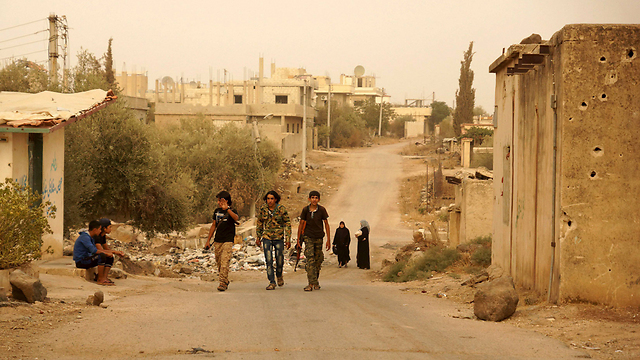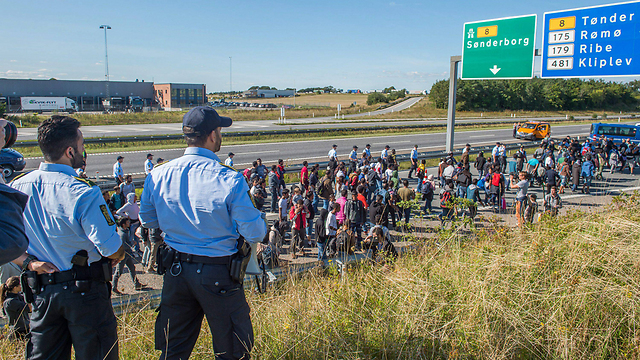
The good, the bad and the ugly: Dividing the State of Syria
Analysis: Syria, as a unified state, no longer exists. With the possibility of a single state being unlikely for the foreseeable future, it might be time to divide the country into several state entities.
Humpty Dumpty had a great fall.
All the king's horses and all the king's men
Couldn't put Humpty Dumpty together again."
- A traditional English children's poem.
Even though restoring stability to Syria is a clear and urgent interest, in the past four years, the international community's response to the bloodshed in the country has been non-existent. This non-action occurred despite the fact that it was clear from the start that the war's consequences would spill beyond Syria's borders.
The instability in Syria is reflected on its neighbors with the waves of refugees fleeing into Lebanon, Turkey, and Jordan. Europe is contending with a mass of refugees standing on its doorstep. This pressure will only increase, due to the huge number of Syrians fleeing combat zones (a third of the 10 million Syrian refugees have left the country. Currently, about 70,000 refugees flee Syria's borders every month). And yet, even with the refugee crisis and the revelation of Russia's military involvement in Syria, it's still unclear whether or not an international effort will be made to stop the bloodshed.
In any case, any attempt to find a solution to the crisis has to acknowledge the fact that Syria, as a sovereign state, is no longer. A single state with a single effective government cannot exist in that country's territory in the foreseeable future. The guiding hope of the international community – that it would be possible to turn back the wheel and stabilize the "old" Syria under a different government – is baseless.
That's why the focus should be on finding a practical replacement to the Syrian state, and developing a practical plan whose outlines will be accepted and agreed upon by regional and global leaders. Any strategic plan intended to bring quiet to Syria and mold its future has to be based on a clear base assumption: The torn-down and broken Syria, much like Humpty Dumpty, cannot be put back together again.
During the civil war, Syria was de-facto split into control zones, whose main attributes are demographic. The internal resident and refugee movement was toward the ethnic-religious population centers in which they felt safer. In fact, even though their interests aren't identical, a split into fairly homogeneous demographic zones occurred.
Under these circumstances, it seems that Syria's de jure splitting into several separate state-like entities on the base of ethnicity is the natural and expected solution – since it also has a real chance to stabilize the area and stop the ongoing war.
According to the suggested plan, the Sunni majority will keep control of most of Syria's territory. In addition to this, international and regional assurances for the safety of minority populations will be given. Three large minority groups are concentrated inside Syria's borders, in three distinct areas: The Alawites in the west, the shore areas; the Druze, mostly in Jabal al-Druze ("mountain of the Druze"), north of Jordan; and the Kurds in the north, near the Turkish border. The outline for a resolution in Syria has to be based on ensuring these communities' existence as independent state entities.
Adopting the outline will be a stopgap measure against the advancement of the Islamic State (ISIS) and other radical Islamic organizations. The Alawites will be able to form a state entity to which the small Shi'ite minority could also belong. That way, the Russians and Iranians could end the conflict with some measure of satisfaction. The shrinking Christian minority, whose members mostly live in large cities and are not concentrated in ways that allow them to form a state entity of their own, must also be protected.
A new diplomatic solution in Syria, which would be based on dividing its territory into several state entities, could have a federative or confederative structure (even though it doesn't have to be either). The proposed solution will aid in minimizing friction between different groups, lowering the threat of constant war and providing defense for minority communities from radical Islamist forces, among them ISIS. A byproduct of the area's stabilization on this basis would also be a halting of the fighting's negative externalities, which aides the rise of Islamic radicalization in the region at large, and specifically in Jordan and Lebanon.
The offered idea has roots in Syrian history. During its mandatory rule in the Levant, France established five semi-state entities, hoping to make them into a future sovereign ruling body. The Druze and Alawite autonomy even had ethnic, demographic features. Four out of these five states were created in September 1920. The "Jabal al-Druze" state was created two years later. The original French idea also made connections between state structures and the protection of minorities.
Bringing back the quiet
At the end of 2013, the Kurds in Syria announced the foundation of an autonomous Kurd region, published a constitution draft, and called for parliamentary elections. Today, the Kurds' fears are focused (as are those of the Druze) on the threat they face from ISIS and the other extremist Sunni organizations. The Kurdish national ambitions in Syria relate to the Kurd minorities in Iraq and Turkey, as well as the perception of nation building and an independent state in the entire area of "Greater Kurdistan." And so, it would be a challenge to get Turkey's support for an agreement which includes a Kurd state entity in Syrian territory. It's possible that superpowers clarifying that the Kurd entity will not expand beyond the Syrian border could ease the expected Turkish resistance.The Druze people's national ambitions are seemingly less powerful than those of the Kurds, and their thoughts mostly revolve around their very survival. And still, it's readily apparent that in the current circumstances a Druze autonomy in southern Syria (of the type they enjoyed in the days of mandatory rule, and which was cancelled as Syria gained independence) might be welcomed by the Druze in the context of the proposed resolution. It is to be expected that regional and international bodies which support this entity's foundation will be found, since it would also be a divider between Jordan to the south and the radical Sunni system in Syria's center.
Such a plan is compatible with the interests of most global and regional players, who seek the return of peace and quiet to Syria – among other reasons, in order to stop ISIS. These include the United States, European countries, the Lebanese and Jordanian regimes and Israel. In spite of the fact that Israeli interests are aligned with this possible solution, it should not be the one to spearhead it in international circles. Israel would, however, preserve its interests along the border area.
The Russian and Iranian approach to this matter will take into account the idea that the war's continuation will endanger their footholds in Syria, and that their interests would be preserved by their connections with the Alawite entity. Among other things, it would be a way for Russia to keep intact its interest on the coastline – the Tartus port.
Continued war in Syria means slaughter, more refugees, terrorism, and even the threat of a takeover of the entire Syrian territories by radical Sunni forces.
However, a coordinated and organized move, whose purpose would be a "separation of forces" between the country's Sunni majority and the Minorities living in it, and which would be taken with international backing and leadership, would be the correct, natural, and stabilizing solution.
About 100 years ago, the Sykes-Picot agreement was signed, dividing the Levant into nation-states, in a process that did not put a heavy emphasis on identities and demographic logic. It's time to bid it farewell, at least in Syria. Reality has already done so, now it's the statesmen's turn.
Former Minister Gideon Sa'ar was a member of the Israeli government's Security Cabinet, and today serves as a senior fellow in the Institute for National Security Studies (INSS). Dr. Gabi Siboni is a senior researcher and the head of the military and strategy program at the INSS.












